Howdy BugFans,
Full disclosure: the BugLady’s copy of Bob Dubois’s Damselflies of the North Woods (aka The Bible) automatically falls open to the page that shows the rear ends of the male Spreadwings.
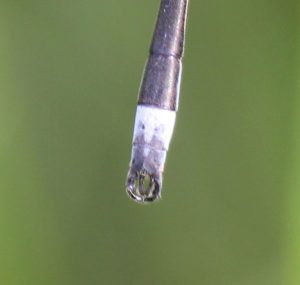
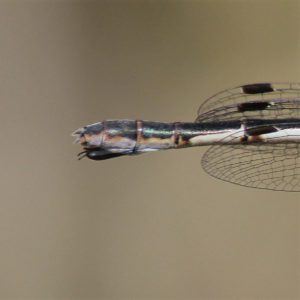
So – what’s a Spreadwing damselfly? The order Odonata has two sub-orders – Anisoptera (dragonflies) and Zygoptera (damselflies). Damselflies are further divided into the Broad-winged damsels (jewelwings and rubyspots), the Narrow-winged damsels (bluets, dancers, forktails, sprites, and more), the Spreadwings (family Lestidae), and a few other small groups. “Spreadwing” describes how they perch – with their wings positioned in a backward-trailing “V.” Usually. Unless it’s cold and rainy or it’s a teneral (newly-emerged).
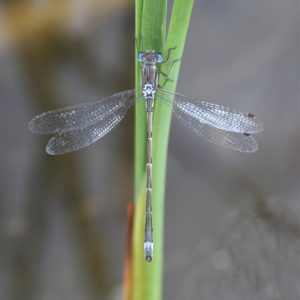
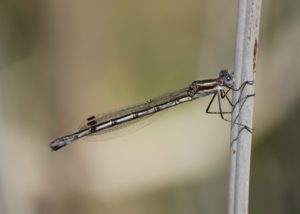
Spreadwings are large for damselflies (1.5” to 2”) and are not particularly brightly-colored. Males have intense blue eyes and females’ eyes are pale blue or brown. Sources agree that both male and female spreadwings can be tricky to ID – definitive identification requires examination of the damselfly’s nether regions with a microscope or hand lens, and in the field, females are best known by the company they keep. Male Southern Spreadwings (https://bugguide.net/node/view/43409/bgimage) look a lot like male Northern Spreadwings https://bugguide.net/node/view/820173/bgimage, which look a lot like male Sweetflag Spreadwings (https://bugguide.net/node/view/477197/bgpage). Photographers, alas, want labels for our pictures, and we sometimes take leaps of faith.
They aren’t strong flyers, and when they perch, it’s often at about a 45 degree angle, not quite as close to the ground as the sprites and bluets often perch. They’re found near still waters with lots of vegetation, preferably with no predatory fish – the ideal habitats for their aquatic offspring. A few live in streams or rivers with a very slow current, and some species are adapted for life in an ephemeral or temporary pond.
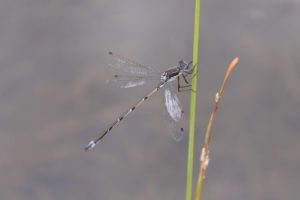
Male spreadwings hang out in the vegetation along the shoreline, but females stay away from the water until they are ready to reproduce. Females lay eggs in plant stems above the waterline, sometimes alone https://bugguide.net/node/view/36973/bgimage, but generally in tandem with a male https://bugguide.net/node/view/1555986/bgimage (he’s guarding his genetic investment). A few spreadwing species follow the general Odonate formula of hatching quickly, feeding, and then spending the winter underwater as a small, partly-grown naiad (immature). Other species of spreadwings, the Southern Spreadwing among them, overwinter as eggs and push the restart button in spring.
Bob DuBois, in Damselflies of the North Woods describes their egg-laying practices this way, “This egg-wintering strategy allows them to utilize temporary ponds and vernal ponds that dry up during the summer or fall, because the eggs do not need to be wet all the time….The eggs immediately take some of the initial developing steps, but before hatching occurs they slip into a state of embryonic diapause (rest). In this state, the drying-resistant eggs spend the winter inside plant stems where they withstand temperatures as cold as it gets in our region ….… after the snows melt and water levels rise in the spring, the dead plant is wetted, providing the moisture needed along with the right increasing temperatures and day-length cues to complete the hatching process. ….. The nymph stage is short for these egg-diapausing species – just two or three months in spring and early summer – because the fast-growing nymphs need to complete their development of about ten instars and emerge before the temporary ponds they live in dry up.”
The biography of SOUTHERN SPREADWINGS (Lestes australis) is similar to that of other spreadwings. Adults are found on the shorelines of quiet, weedy ponds and marshes. They’re the earliest Lestes species on the landscape, and they have a very short flight period, appearing in May and fading before the end of June. Adults eat small insects that they snag in the air, and naiads feed on the tiny aquatic invertebrates that they swim around with.
One of the reasons that Southern Spreadwings are so hard to distinguish from Northern Spreadwings is that they both used to be subspecies of the same species, the Common Spreadwing, and therein lies what Paul Harvey used to call “The rest of the story.” Any birder can tell you of the joys of “lumping” and “splitting,” in which the Powers That Be split a species, creating another potential check-off for your life list, or lump two or three species, lowering your total (brace yourself birders – the Red Crossbills are about to explode).
Anyway, the Common Spreadwing was split. Says Paulson of the Southern Spreadwing, in Dragonflies and Damselflies of the East, “With some structural differences and a somewhat different flight season, it probably deserves its rank as a full species, but genetic differences between the two are less than those between most species of spreadwings.” To add to the confusion, Southern Spreadwings, whose historical range as a subspecies is south of Wisconsin, are moving north.
Scientists and citizen scientists are scrambling to define the edges of the range of the two species. It may be impossible to know which of the early/pre-split Common Spreadwing records were the (now) Northern or the (now) Southern species, especially where the ranges of the subspecies overlapped. Bugguide.net plots its range maps based on photos submitted by its members, and although they’re here, Wisconsin is not included on the Southern Spreadwing’s map yet.
Do Southern Spreadwings have resident populations here in Wisconsin or do they just migrate here? DuBois says “It is not known if this species breeds successfully in our region, or if adults seen here move up from the south.” They’ve been recorded in 13 Wisconsin counties https://wiatri.net/inventory/odonata/speciesaccounts/SpeciesDetail.cfm?TaxaID=168, and we know there is breeding activity, but are our winters too cold, for too long, to allow the egg in the stem in the open to make it to spring?
Finally, and at the risk of causing Lestes Overload – also moving into our neighborhoods is the Great Spreadwing (Archilestes grandis), a large (up to 2.4”) species native to the west and south whose range now extends to Massachusetts and Ontario (and includes Wisconsin https://wiatri.net/inventory/odonata/speciesaccounts/SpeciesDetail.cfm?TaxaID=126. The range expansion may be due to climate change, or it may be explained by a proliferation of ditches and farm ponds (the naiad is tolerant of pollution) that allowed the species to hop-scotch across the continent. Keep your eyes peeled.
The BugLady recommends this lovely offering from Chicago’s Field Museum of Natural History: https://fieldguides.fieldmuseum.org/sites/default/files/rapid-color-guides-pdfs/388_0.pdf
Also – many thanks to BugFan Freda, whose pictures of the Southern Spreadwing are far better than the BugLady’s.
Think damselflies.
Kate Redmond, The BugLady
Bug of the Week archives:
http://uwm.edu/field-station/category/bug-of-the-week/
